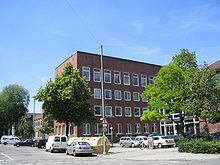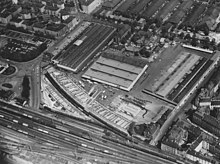Munich slaughterhouse and cattle yard
The slaughter and cattle yard Munich is a plant for the slaughter and wholesale of food in the Munich District Isarvorstadt in the district 2 Ludwig-Isarvorstadt .
history
Up until 1878 there were two public slaughterhouses in Munich , one on Färbergraben and one on Viktualienmarkt . Both were used by the "bank butchers" who had their stalls at the Viktualienmarkt. The other butchers and innkeepers slaughtered at home, some in backyards that were scattered all over town.
The cattle market was on Herrnstrasse. The animals moved through the streets of the city, which were heavily polluted as a result. Traffic was hindered and passers-by were at risk. Problems of environmental protection - one would say today - arose. In addition, there were demands that arose from the new knowledge of hygiene . Sick animals, slaughterhouse waste and wastewater were a constant source of danger.
The devastating occurrence of cholera in 1866, which claimed many lives in Munich, as well as the demands of the hygienist Max von Pettenkofer, led to the amendment of the Police Criminal Code in 1871 as a prerequisite for the creation of central communal slaughterhouses .
After a detailed examination of the site requirements (rail connection, expansion options, water law problems, etc.) and taking into account the latest knowledge of hygiene, the Munich slaughterhouse and cattle yard was built between 1876 and 1878 according to the plans of the city building officer Arnold Zenetti .
The Munich slaughterhouse and cattle yard survived the first years of the Second World War quite unscathed. The situation changed dramatically from 1943 on. The air strikes became more frequent and more violent. Approx. 65 percent of the built-up area of the slaughterhouse and cattle yard was destroyed.
After the city council spoke out in 1964 for a renewal of the slaughterhouse at the old location and thus against relocation to the outskirts, a cattle slaughterhouse and tripe , a cattle and pork cold store and a meat market building were newly built in the 1970s .
With the rehabilitation of the pig slaughter (1987/89), the slaughter of large cattle (1990/92) and the meat market (1995/96), the three core areas were brought up to date with the latest technology and hygiene. They are flanked by a large number of relevant trade and craft businesses with a multicultural range of products.
In the course of the dissolution of the municipal veterinary department in 1996, the slaughterhouse and cattle yard, the official veterinarian department , the tasks of carcass removal and food waste disposal as well as the district administration and district tasks relating to the animal welfare and animal disease law remained in one organizational unit as the “urban slaughter” - and Viehhof "combined, the veterinary office became its own office.
After the privatization of cattle slaughter on April 1, 2000 and the privatization of pig slaughter on April 1, 2004, the municipal slaughterhouse and cattle yard was transferred to the company's own slaughterhouse in Munich on January 1, 2005 , whose focus is on branch-specific area and property management. The last Munich horse market took place in 2006 . On January 1, 2007 , the Munich slaughterhouse merged with the Munich wholesale market under the new name of Markthallen München to become a joint company.
administration
The slaughterhouse and cattle yard, which is part of the Markthallen München business, is looked after by the municipal department . The municipal officer Kristina Frank is also the first plant manager and determines the economic policy direction. The second plant manager (formerly director) is responsible for the operational business.
The Munich slaughterhouse is run as a municipal operation for historical and local political reasons . Other slaughterhouses in Germany are run as direct operations , own operations , GmbHs (purely municipal or with participation), cooperatives (of the resident companies) or as purely private companies. Operating a slaughterhouse is not a statutory duty of a municipality, so there are also the various legal forms mentioned above.
The use of the slaughterhouse site for slaughterhouses, tenants and buyers is regulated by the usage statutes .
The various fees and rents for buildings, parking spaces, offices and others are based on the fee statute or the corresponding rental agreements.
Others
- In the slaughterhouse in Munich, in addition to slaughtering (which is becoming ever smaller), wholesale business in meat , poultry , fish and delicatessen is carried out.
- Since filming the television series to freedom is the Tavern at the slaughterhouse a popular cultural meeting place. The Ottis Schlachthof cabaret series with Ottfried Fischer , its follow -up show Schlachthof , and the R&B Show , a music program moderated by Susanne Rohrer and Christiane Brammer , were or are being produced here for television .
- The area of the Isarvorstadt district north of the railway line is also known as the Schlachthausviertel or Schlachthofviertel .
- The slaughterhouse and the wholesale market hall are collectively known as the “ belly of Munich ”
- The Munich Horse Market took place here from 1876 to 2006 .
literature
- A. Zenetti: Cattle and slaughterhouse in Munich. (Text and plan collection, large format 463 mm × 330 mm) Verlag Franz, Bolster & Mayer, Munich 1880. (Arnold Zenetti, Munich November 1879)
- Ferdinand Opel: The municipal slaughterhouse and cattle yard in Munich. (Festschrift for the fifty-year existence), Deukula, Munich 1928.
- Christian Haeutle: 75 years of the Munich slaughterhouse and cattle yard: 1878–1953. City Veterinary Directorate Munich, 1953.
- Canan-Aybüken Aybar: History of the Munich slaughterhouse and cattle yard. (Dissertation), University of Munich, Munich 2005.
Web links
- Homepage on schlachthof-muenchen.de
- The Munich slaughterhouse in the official city map of Munich on geoinfo-muenchen.de
- Wirtshaus im Schlachthof on im-schlachthof.de
Coordinates: 48 ° 7 ′ 24 ″ N , 11 ° 33 ′ 26 ″ E




